Introduction to Plastic Surgery Recovery Times
Understanding recovery times and healing durations after plastic surgery is crucial for setting realistic expectations and optimizing post-operative care. This article presents 33 key facts about healing times, drawn from extensive statistical data, clinical studies, and expert guidelines. These facts cover a broad spectrum of plastic surgery procedures, the biological phases of healing, factors affecting recovery outcomes, common challenges, and trends influencing the field. Whether you are considering surgery or currently in recovery, these insights provide a data-driven overview to help navigate the healing journey effectively.
Plastic Surgery Recovery and Healing Key Facts
- Recovery times vary widely depending on procedure type and individual health status.
- Minimally invasive procedures like Botox and fillers typically require just 1-2 days for recovery.
- Swelling peaks in the first few days and gradually subsides over weeks, affecting comfort and movement.
- Breast surgery often causes temporary numbness; permanent sensation loss occurs in about 2% of cases.
- Recovery from breast augmentation is usually within one week, whereas tummy tuck can take 6-8 weeks for full healing.
- Facelift recovery involves weeks for initial healing and months for final results, with scars maturing over about a year.
- Liposuction recovery spans 2-4 weeks, with light activities encouraged early and strenuous exercise delayed.
- Rhinoplasty recovery can take up to a year for complete swelling resolution, with initial return to work in 2 weeks.
- Most patients resume normal routines between 3 to 6 weeks post-surgery, with swelling and bruising resolving in this period.
- Advancements in surgical techniques have led to shorter recovery periods, with faster return to daily activities.
1. Recovery Time Varies by Procedure Type and Individual Factors
 Recovery times after facial and body surgeries can differ widely based on the specific procedure and the person's overall health. Less invasive treatments like Botox or facial fillers typically require just about a week before returning to normal activities. More involved surgeries, such as tummy tucks or facelifts, may take several weeks to months for full healing. Age and pre-existing health conditions also influence recovery, with older adults often experiencing longer healing due to less elastic skin and slower tissue repair. Good health, proper care, and avoiding habits like smoking can help speed recovery. Understanding these factors helps set realistic expectations and promotes better healing.
Recovery times after facial and body surgeries can differ widely based on the specific procedure and the person's overall health. Less invasive treatments like Botox or facial fillers typically require just about a week before returning to normal activities. More involved surgeries, such as tummy tucks or facelifts, may take several weeks to months for full healing. Age and pre-existing health conditions also influence recovery, with older adults often experiencing longer healing due to less elastic skin and slower tissue repair. Good health, proper care, and avoiding habits like smoking can help speed recovery. Understanding these factors helps set realistic expectations and promotes better healing.
2. Minimally Invasive Procedures Have Shortest Recovery Periods
 Procedures like Botox and dermal fillers usually require minimal downtime, allowing patients to return to their daily routines quickly. Most individuals can resume normal activities within a day or two, making them popular options for those seeking faster recovery.
Procedures like Botox and dermal fillers usually require minimal downtime, allowing patients to return to their daily routines quickly. Most individuals can resume normal activities within a day or two, making them popular options for those seeking faster recovery.
3. Swelling Peaks Within First Few Days After Facial Surgeries
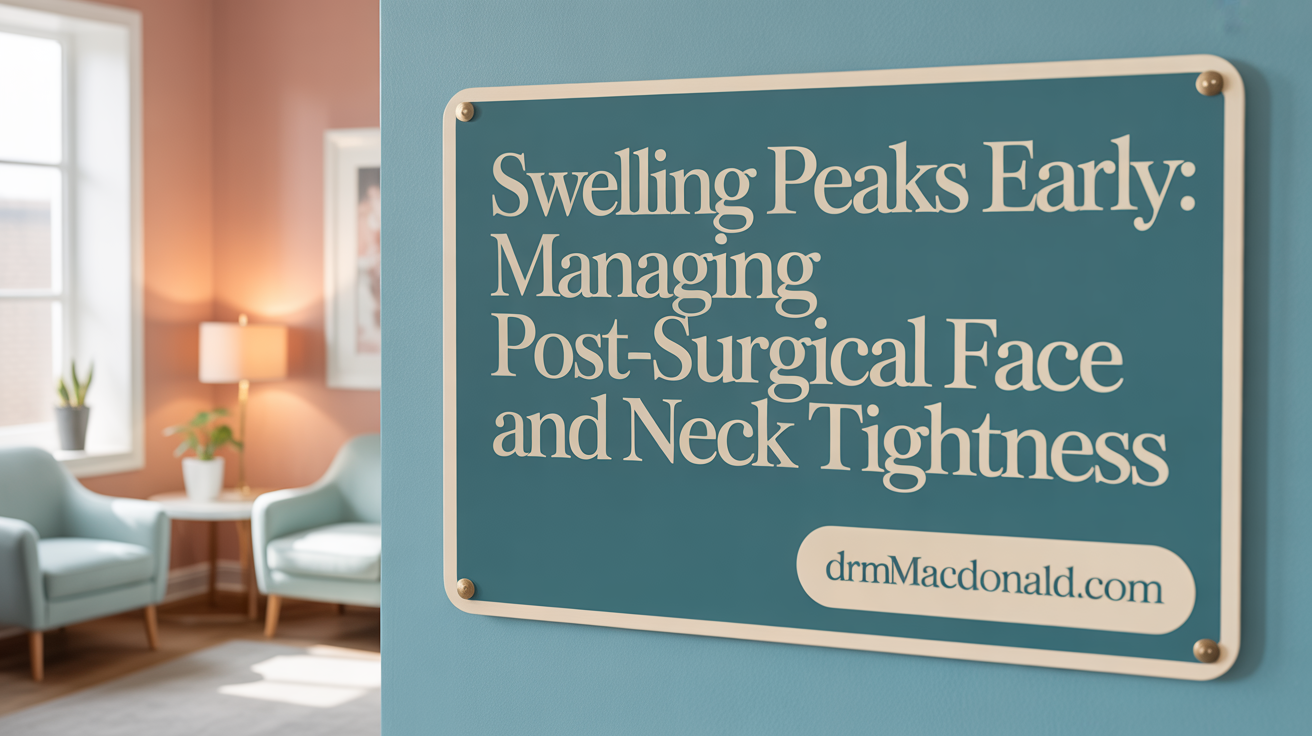 Swelling after facial surgery usually reaches its peak within the first few days. During this period, patients often experience tightness in the face and neck, which may temporarily limit mouth opening, head turning, and smiling. This swelling gradually subsides over the following weeks, allowing for improved facial movement and comfort. Managing swelling early on is essential for smoother recovery, and keeping the head elevated can help reduce pressure and promote healing.
Swelling after facial surgery usually reaches its peak within the first few days. During this period, patients often experience tightness in the face and neck, which may temporarily limit mouth opening, head turning, and smiling. This swelling gradually subsides over the following weeks, allowing for improved facial movement and comfort. Managing swelling early on is essential for smoother recovery, and keeping the head elevated can help reduce pressure and promote healing.
4. Breast Surgery Often Causes Temporary Numbness
 Numbness in the breasts or nipples after breast surgery is common but typically temporary. Studies indicate that only about 2% of women experience permanent sensation loss. During nerve re-establishment, patients may feel hypersensitivity such as itching, burning, or sharp twinges, which can take months to resolve. This process is part of the body's natural healing and nerve regeneration phases following surgery.
Numbness in the breasts or nipples after breast surgery is common but typically temporary. Studies indicate that only about 2% of women experience permanent sensation loss. During nerve re-establishment, patients may feel hypersensitivity such as itching, burning, or sharp twinges, which can take months to resolve. This process is part of the body's natural healing and nerve regeneration phases following surgery.
5. Recovery Timeframes: Breast Augmentation vs. Tummy Tuck
 Patients typically return to work within one week following breast augmentation, with full healing taking up to six weeks. In contrast, tummy tuck recovery involves light activities by two weeks but can extend to six or eight weeks for complete healing. While both procedures have similar initial recovery periods, the longer healing process for tummy tucks reflects the invasiveness of the surgery.
Patients typically return to work within one week following breast augmentation, with full healing taking up to six weeks. In contrast, tummy tuck recovery involves light activities by two weeks but can extend to six or eight weeks for complete healing. While both procedures have similar initial recovery periods, the longer healing process for tummy tucks reflects the invasiveness of the surgery.
6. Facelift Recovery Takes Weeks for Initial Healing and Months for Final Results
 Most patients can return to work within two weeks after a facelift. Swelling and bruising typically decrease significantly within this period, though some residual swelling may last up to three months. Scar maturation is a gradual process; scars usually become flatter and lighter over about six weeks, but the final appearance and full healing of scars can take several months, often up to a year. Patience during this time ensures optimal healing and the best possible results.
Most patients can return to work within two weeks after a facelift. Swelling and bruising typically decrease significantly within this period, though some residual swelling may last up to three months. Scar maturation is a gradual process; scars usually become flatter and lighter over about six weeks, but the final appearance and full healing of scars can take several months, often up to a year. Patience during this time ensures optimal healing and the best possible results.
7. Liposuction Recovery Typically Spans 2 to 4 Weeks Depending on Areas Treated
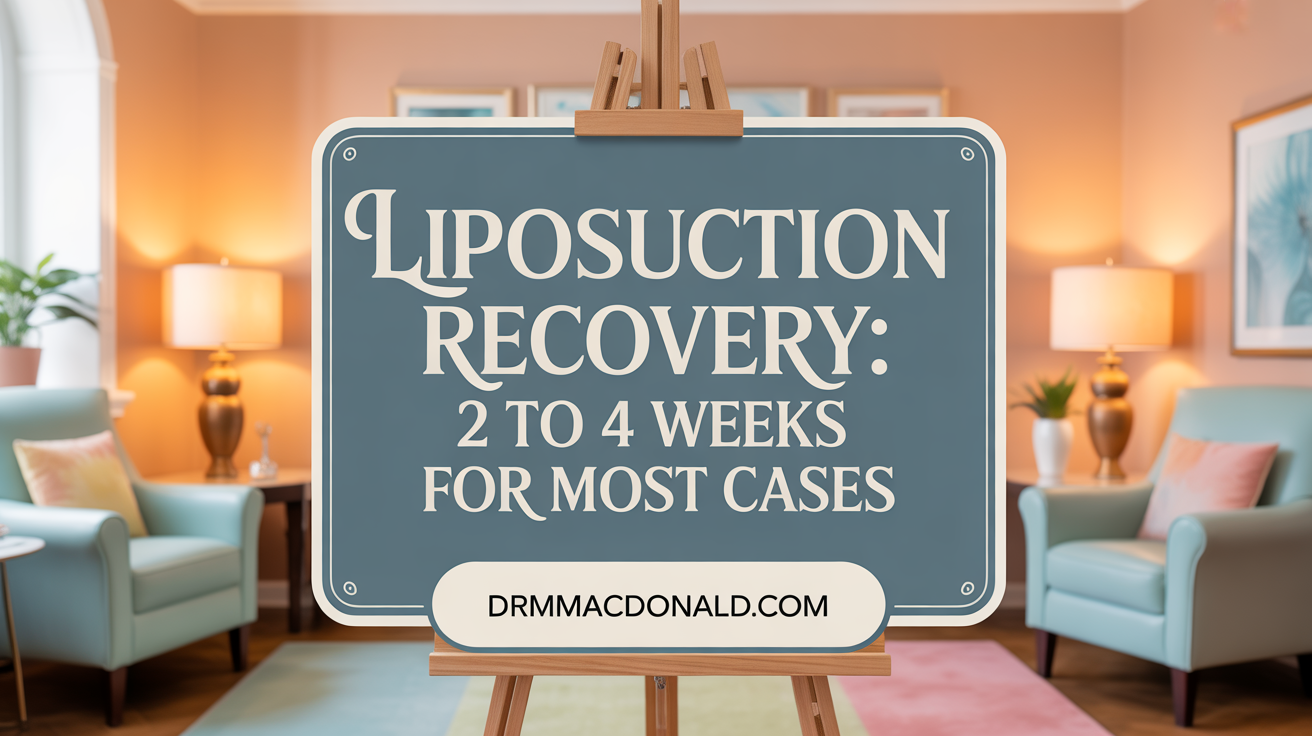 Liposuction recovery usually takes between two and four weeks. During this time, patients are encouraged to start with light activities, such as walking, to promote circulation and reduce risks like blood clots. Strenuous exercise, however, should be avoided for at least two to three weeks to prevent tension on incision sites and ensure proper healing. Gradually resuming regular activities depends on individual progress and the areas treated.
Liposuction recovery usually takes between two and four weeks. During this time, patients are encouraged to start with light activities, such as walking, to promote circulation and reduce risks like blood clots. Strenuous exercise, however, should be avoided for at least two to three weeks to prevent tension on incision sites and ensure proper healing. Gradually resuming regular activities depends on individual progress and the areas treated.
8. Rhinoplasty Has One of the Longest Full Healing Periods, Up to a Year
 Rhinoplasty recovery involves a gradual reduction in swelling, which can take up to a year to fully resolve. Patients typically return to work within two weeks, but final results, including aesthetic improvements, are often seen after the swelling subsides over several months.
Rhinoplasty recovery involves a gradual reduction in swelling, which can take up to a year to fully resolve. Patients typically return to work within two weeks, but final results, including aesthetic improvements, are often seen after the swelling subsides over several months.
9. Most Patients Resume Regular Daily Routines Between 3 to 6 Weeks Post-Surgery

Typical recovery milestones include significant reduction in swelling and bruising, usually by three to six weeks. During this period, most patients notice their face or body appearing more natural, with much of the swelling gone.
By this time, lingering soreness and discomfort should clear up, and patients often feel ready to return to light daily activities, though more strenuous tasks may still need to be postponed. Many can see most of their final results, and scars tend to become flatter and lighter around this time.
Swelling and bruising tend to resolve markedly within these weeks, making the recovery period more comfortable. Wearing compression garments and proper wound care can speed up healing. Overall, three to six weeks mark a crucial phase where recovery progresses substantially, allowing patients to gradually resume their normal routines.
10. Swelling and Bruising Usually Resolve Within the First Few Weeks
 Swelling and bruising after surgery typically decrease significantly within three to six weeks. Most patients notice a reduction in these symptoms, allowing them to see their full results. This healing phase marks an important milestone, as lingering swelling may obscure final outcomes and resolve gradually over months.
Swelling and bruising after surgery typically decrease significantly within three to six weeks. Most patients notice a reduction in these symptoms, allowing them to see their full results. This healing phase marks an important milestone, as lingering swelling may obscure final outcomes and resolve gradually over months.
11. Gender Does Not Significantly Affect Recovery Duration
 Studies indicate that recovery times after cosmetic procedures are similar for men and women. Both genders generally experience comparable healing durations, with minor variations depending on individual health and procedure type.
Studies indicate that recovery times after cosmetic procedures are similar for men and women. Both genders generally experience comparable healing durations, with minor variations depending on individual health and procedure type.
12. Desk Job Patients Often Return to Work Within One Week After Minor Surgery
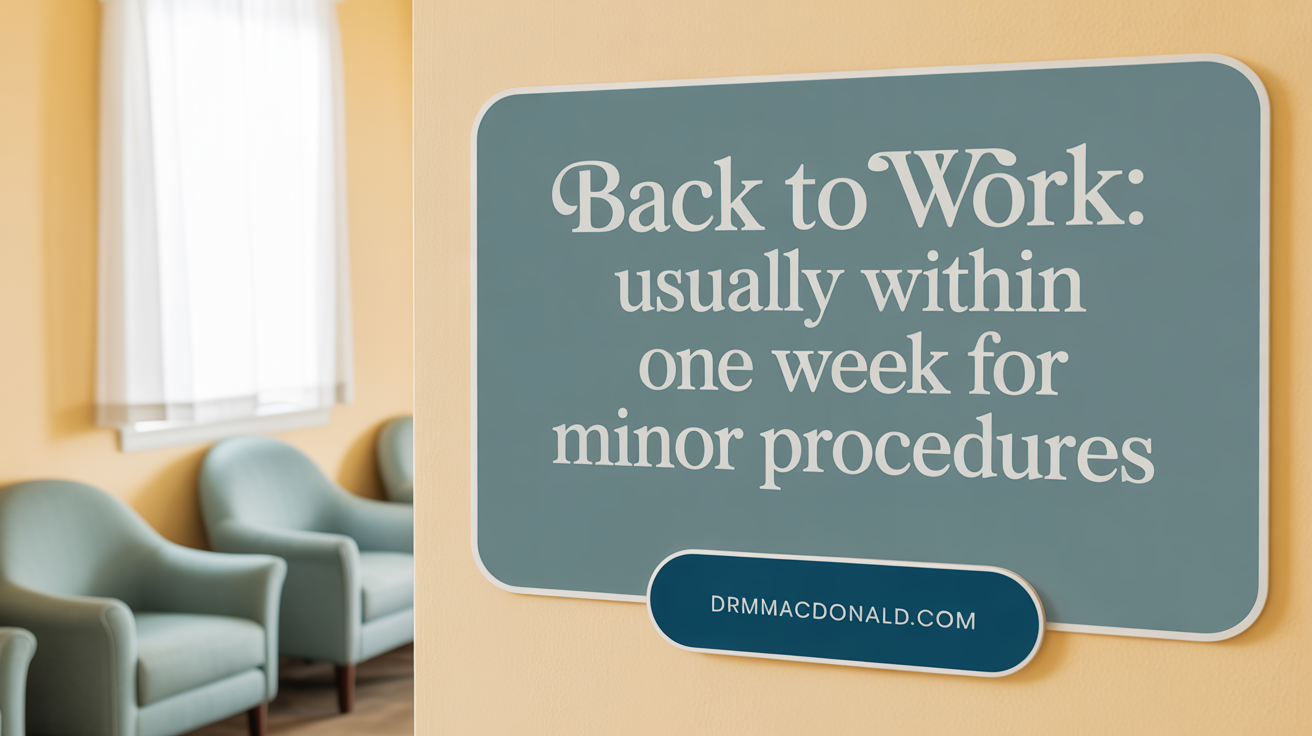 Most patients with desk jobs can usually go back to work about a week after minor procedures. Light tasks are fine to resume early, but more strenuous activities should be avoided for another week or two to ensure optimal healing and prevent complications.
Most patients with desk jobs can usually go back to work about a week after minor procedures. Light tasks are fine to resume early, but more strenuous activities should be avoided for another week or two to ensure optimal healing and prevent complications.
13. Significant Fat Removal Requires Longer Rest and Delayed Strenuous Activity
 Patients who undergo extensive liposuction involving multiple areas should plan for a longer rest period and delay vigorous activities. Proper postoperative rest helps reduce swelling, prevents complications, and promotes better healing. Recovery speed can be affected by the extent of fat removal, with more invasive procedures demanding more patience and care to achieve optimal results and minimize risks.
Patients who undergo extensive liposuction involving multiple areas should plan for a longer rest period and delay vigorous activities. Proper postoperative rest helps reduce swelling, prevents complications, and promotes better healing. Recovery speed can be affected by the extent of fat removal, with more invasive procedures demanding more patience and care to achieve optimal results and minimize risks.
14. Complete Results and Swelling Reduction Can Take Six Months to a Year
 Full healing and swelling reduction often span six months to a year. During this time, the inflammatory phase transitions to scar maturation, where scars become lighter and flatter. Patients typically see final aesthetic results around this period, with ongoing improvement in swelling and tissue refinement.
Full healing and swelling reduction often span six months to a year. During this time, the inflammatory phase transitions to scar maturation, where scars become lighter and flatter. Patients typically see final aesthetic results around this period, with ongoing improvement in swelling and tissue refinement.
15. Elevating the Head Post-Facial Surgery Improves Healing and Reduces Pressure
 Keeping the head elevated after facial surgery helps manage swelling and promotes better blood flow. Proper positioning reduces pressure on incisions, decreasing discomfort and aiding faster recovery. Elevating the head also enhances circulation, which is vital for delivering nutrients and oxygen to healing tissues, supporting the body's natural repair processes. Patients are encouraged to sleep or sit with their head raised to optimize healing outcomes and minimize swelling discomfort.
Keeping the head elevated after facial surgery helps manage swelling and promotes better blood flow. Proper positioning reduces pressure on incisions, decreasing discomfort and aiding faster recovery. Elevating the head also enhances circulation, which is vital for delivering nutrients and oxygen to healing tissues, supporting the body's natural repair processes. Patients are encouraged to sleep or sit with their head raised to optimize healing outcomes and minimize swelling discomfort.
16. Protective Posture After Tummy Tuck Usually Includes a Slight Hunch

What are typical posture changes during early recovery?
After a tummy tuck, patients often adopt a slightly hunched position temporarily. This is a natural, protective response designed to reduce tension on the surgical area and minimize discomfort. As healing progresses and swelling subsides, patients typically regain a more natural, upright posture.
How does swelling influence posture?
Swelling, which peaks a few days post-surgery, can cause the face, neck, or abdomen to feel tight and uncomfortable. This tightness can influence posture, making it appear more hunched to avoid aggravating swelling or discomfort. Once swelling decreases, usually within a few weeks, patients often find they can stand and move more normally, with many experiencing improved posture after full recovery.
17. Nerve Sensory Changes in Recovery Include Hypersensitivity and Tend to Subside Over Months
 After surgery, nerve healing can result in sensory changes such as itching, burning, and sharp sensations. These symptoms are part of the nerve re-establishment process, which can take several months to resolve. During the initial healing stages, patients may experience hypersensitivity as nerves regenerate. Over time, as nerves mature and scar tissue forms, these sensations typically decrease, leading to improved sensory function and comfort.
After surgery, nerve healing can result in sensory changes such as itching, burning, and sharp sensations. These symptoms are part of the nerve re-establishment process, which can take several months to resolve. During the initial healing stages, patients may experience hypersensitivity as nerves regenerate. Over time, as nerves mature and scar tissue forms, these sensations typically decrease, leading to improved sensory function and comfort.
18. Emotional and Cognitive Effects Like Brain Fog and Irritability Are Common During Early Recovery

How does surgery impact psychological well-being?
Many patients experience emotional changes such as feelings of tiredness, irritability, and mental fog during early recovery. These symptoms are often temporary and linked to the body's response to anesthesia, pain medications, and altered sleep patterns.
What role do medications and anesthesia play?
Anesthesia and painkillers can affect mood and cognitive function temporarily. As the drugs wear off and healing progresses, most patients find that these emotional and mental symptoms improve significantly.
19. Plastic Surgery Recovery Involves Inflammatory and Proliferative Healing Phases

What are the biological stages of healing?
Immediately after surgery, the body enters the inflammatory phase, characterized by redness, swelling, pain, and blood vessel dilation, which helps initiate healing. This is followed by the proliferative phase, where new tissue forms, blood vessels grow, and collagen is produced to rebuild the tissue. Over time, the remodeling phase occurs, during which scars mature, becoming flatter and lighter.
How long does each phase typically last?
The inflammatory response usually lasts around 48 hours. The proliferative phase spans from 7 to 21 days, involving tissue regeneration and scar formation. Scar maturation can take several months, often around six weeks for incision healing, but full healing and optimal scar appearance may take up to a year. These durations can vary based on individual health, age, and the type of procedure performed.
20. Inflammatory Phase Is Characterized by Redness, Swelling, and Pain, Initiating Repair
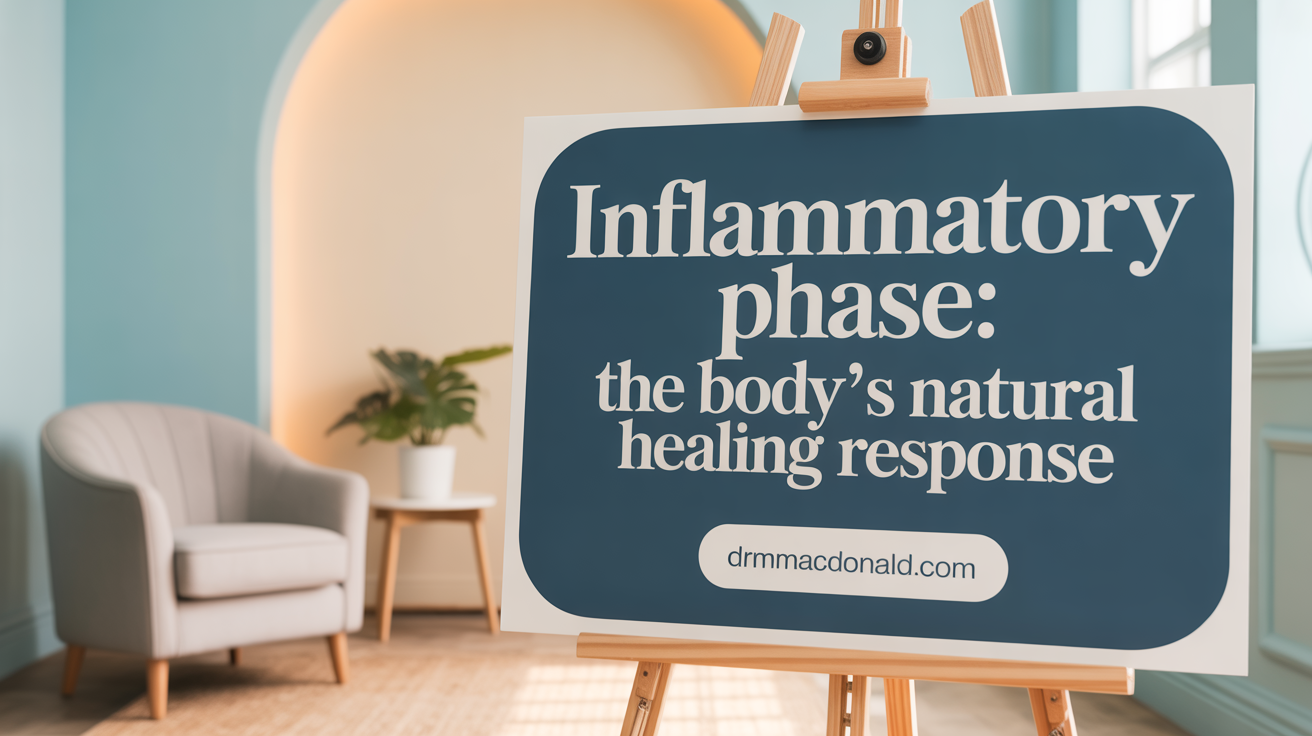 The early period following surgery often involves redness, swelling, and pain. These symptoms are part of the body's natural inflammatory response that begins immediately after tissue injury to promote healing. During this phase, blood vessels dilate to increase blood flow, delivering vital nutrients and immune cells to the site. This process initiates the body's repair mechanisms, setting a foundation for tissue regeneration and scar formation.
The early period following surgery often involves redness, swelling, and pain. These symptoms are part of the body's natural inflammatory response that begins immediately after tissue injury to promote healing. During this phase, blood vessels dilate to increase blood flow, delivering vital nutrients and immune cells to the site. This process initiates the body's repair mechanisms, setting a foundation for tissue regeneration and scar formation.
21. Proliferative Phase Includes Tissue Regeneration and Scar Formation Lasting Several Weeks
 During the proliferative phase of wound healing, the body actively rebuilds tissue through collagen production and new blood vessel formation, known as angiogenesis. This period is crucial for tissue strength and functionality. Scar development begins as collagen fibers organize, resulting in a gradually lighter and flatter scar over time, typically within six weeks.
During the proliferative phase of wound healing, the body actively rebuilds tissue through collagen production and new blood vessel formation, known as angiogenesis. This period is crucial for tissue strength and functionality. Scar development begins as collagen fibers organize, resulting in a gradually lighter and flatter scar over time, typically within six weeks.
22. Scar Maturation Typically Takes Around Six Weeks for Incision Healing
 Scar appearance improves over time as tissue remodeling occurs. During the first six weeks, scars become flatter and lighter, gradually blending with surrounding skin. This period marks the primary phase of scar maturation, where collagen fibers reorganize and scar tissue strengthens.
Scar appearance improves over time as tissue remodeling occurs. During the first six weeks, scars become flatter and lighter, gradually blending with surrounding skin. This period marks the primary phase of scar maturation, where collagen fibers reorganize and scar tissue strengthens.
23. Obesity Can Delay Healing Due to Impaired Vascularity and Nutritional Deficiencies
 Obesity often impairs the healing process after surgery because it causes vascular insufficiency and disrupts immune function. Excess adipose tissue develops its own blood supply, but this is often inadequate, leading to tissue hypoxia, which hampers oxygen delivery vital for wound repair. Additionally, obese individuals frequently experience nutritional deficiencies, such as low levels of vitamin D, zinc, and iron, which are essential for tissue regeneration. These factors combined slow down healing, increase the risk of wound infection, and may prolong recovery. Proper management and addressing these issues are crucial for optimal postoperative outcomes in obese patients.
Obesity often impairs the healing process after surgery because it causes vascular insufficiency and disrupts immune function. Excess adipose tissue develops its own blood supply, but this is often inadequate, leading to tissue hypoxia, which hampers oxygen delivery vital for wound repair. Additionally, obese individuals frequently experience nutritional deficiencies, such as low levels of vitamin D, zinc, and iron, which are essential for tissue regeneration. These factors combined slow down healing, increase the risk of wound infection, and may prolong recovery. Proper management and addressing these issues are crucial for optimal postoperative outcomes in obese patients.
24. Older Age Is Associated with Longer Recovery Due to Reduced Skin Elasticity
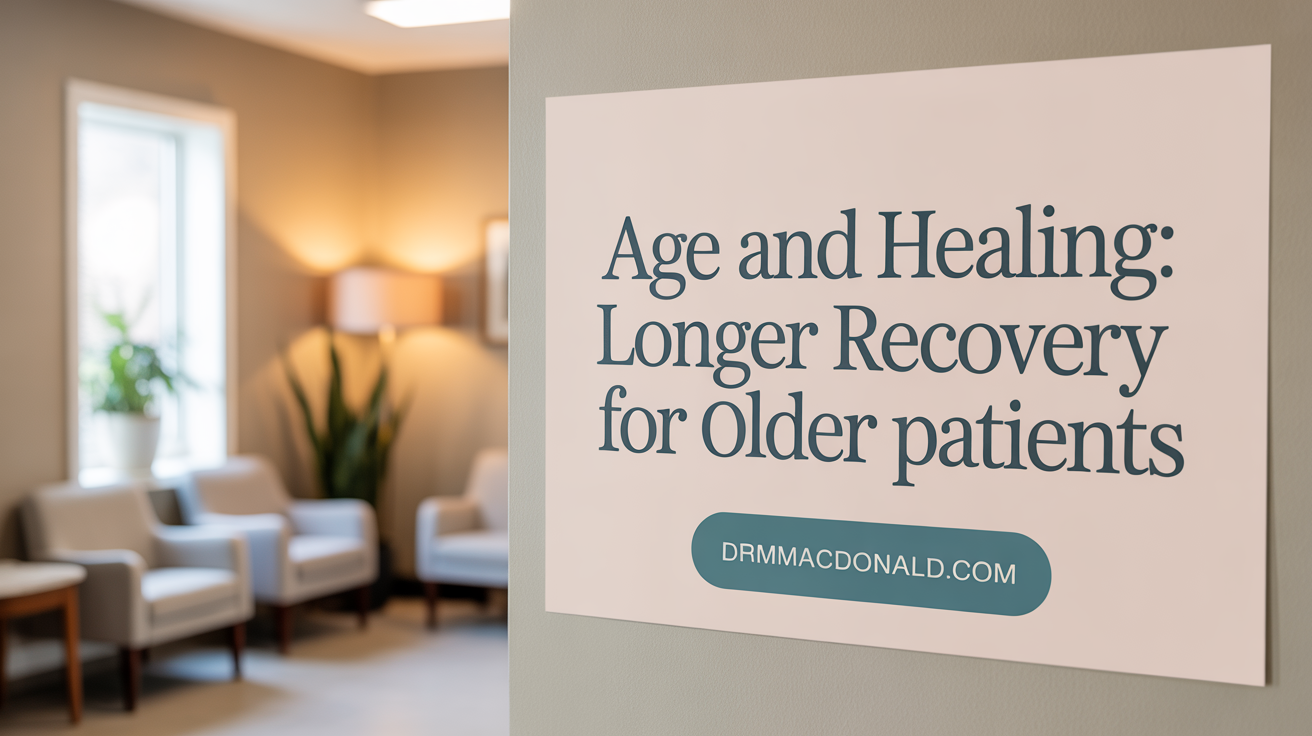 As people age, their skin produces less collagen and elastin, essential proteins for skin strength and elasticity. This reduction leads to less resilient skin that heals more slowly after surgery. Consequently, older patients often experience longer recovery times, with more noticeable scarring and delayed healing compared to younger individuals. These age-related changes necessitate tailored recovery plans and patience during healing.
As people age, their skin produces less collagen and elastin, essential proteins for skin strength and elasticity. This reduction leads to less resilient skin that heals more slowly after surgery. Consequently, older patients often experience longer recovery times, with more noticeable scarring and delayed healing compared to younger individuals. These age-related changes necessitate tailored recovery plans and patience during healing.
25. Pre-Existing Conditions Like Diabetes and Cardiovascular Disease Can Prolong Recovery
 Patients with chronic conditions such as diabetes and cardiovascular disease often experience impaired circulation, which can slow down blood flow to healing tissues. This reduced blood supply delays wound healing and increases the risk of complications, resulting in longer recovery times after surgery. Proper management of these conditions before and after surgery is crucial to promote optimal healing and reduce risks.
Patients with chronic conditions such as diabetes and cardiovascular disease often experience impaired circulation, which can slow down blood flow to healing tissues. This reduced blood supply delays wound healing and increases the risk of complications, resulting in longer recovery times after surgery. Proper management of these conditions before and after surgery is crucial to promote optimal healing and reduce risks.
26. Lifestyle Factors Such as Smoking and Alcohol Consumption Negatively Affect Healing Times
 Smoking and excessive alcohol use can impair blood circulation, leading to delayed wound healing, increased risk of infections, and poor surgical outcomes. These habits hinder the delivery of oxygen and nutrients essential for tissue repair, thus prolonging recovery times.
Smoking and excessive alcohol use can impair blood circulation, leading to delayed wound healing, increased risk of infections, and poor surgical outcomes. These habits hinder the delivery of oxygen and nutrients essential for tissue repair, thus prolonging recovery times.
27. Early Mobilization Encouraged to Reduce Blood Clot Risk and Promote Circulation Post-Surgery
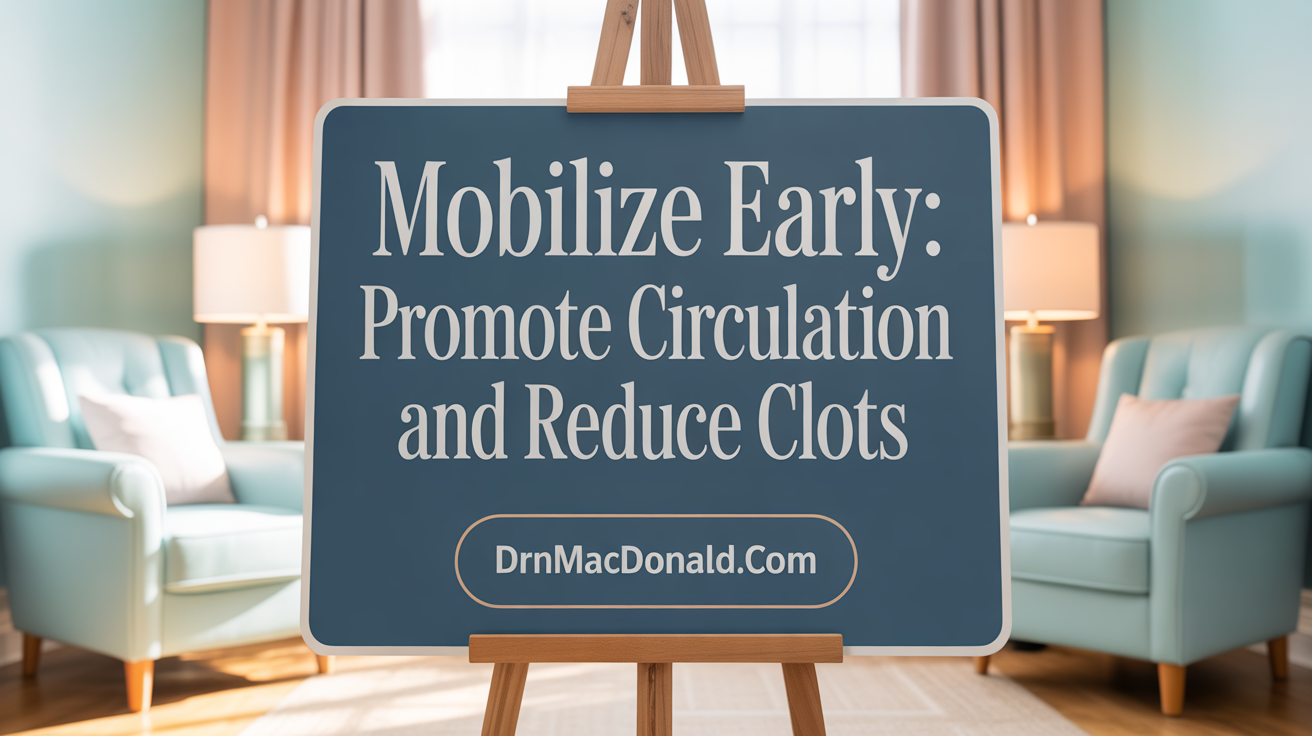 Moving around soon after surgery, within safe limits, helps improve blood flow and decrease the chance of blood clots. Patients are encouraged to walk gently and gradually increase activity levels as approved by their surgeon. It is important to avoid strenuous movements that can stress healing incisions or cause complications. Following these guidelines supports faster recovery and better surgical results while ensuring safety during the healing process.
Moving around soon after surgery, within safe limits, helps improve blood flow and decrease the chance of blood clots. Patients are encouraged to walk gently and gradually increase activity levels as approved by their surgeon. It is important to avoid strenuous movements that can stress healing incisions or cause complications. Following these guidelines supports faster recovery and better surgical results while ensuring safety during the healing process.
28. Compression Garments Help Reduce Swelling and Bruising During Recovery
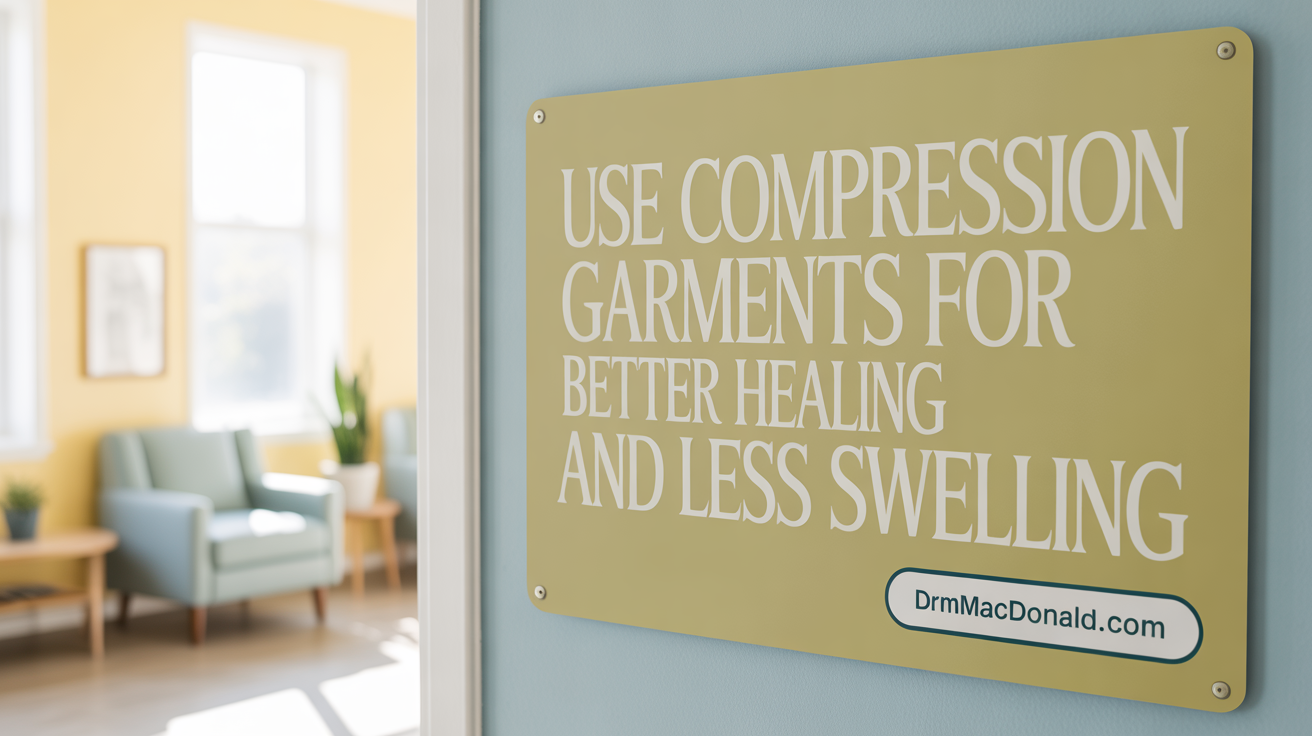 Wearing compression garments during recovery can significantly decrease swelling and bruising, aiding in smoother healing. It is recommended to consistently wear these garments as instructed by your surgeon, especially in the first few weeks post-surgery. Proper use not only improves blood flow but also helps shape the treated area, supporting optimal results and comfort.
Wearing compression garments during recovery can significantly decrease swelling and bruising, aiding in smoother healing. It is recommended to consistently wear these garments as instructed by your surgeon, especially in the first few weeks post-surgery. Proper use not only improves blood flow but also helps shape the treated area, supporting optimal results and comfort.
29. Adherence to Surgeon’s Customized Recovery Plan Is Crucial for Optimal Healing
 Following your surgeon’s tailored recovery plan, including regular follow-up, helps ensure proper healing and reduces complications.
Following your surgeon’s tailored recovery plan, including regular follow-up, helps ensure proper healing and reduces complications.
30. Psychological Support From Family and Caregivers Facilitates Emotional and Physical Recovery
 Support from family and caregivers plays a vital role in recovery after facial and body surgeries. Emotional backing helps patients manage feelings of lethargy, irritability, and anxiety that are common post-surgery.
Support from family and caregivers plays a vital role in recovery after facial and body surgeries. Emotional backing helps patients manage feelings of lethargy, irritability, and anxiety that are common post-surgery.
Having a strong support system encourages adherence to important care routines, such as wearing compression garments, following medication schedules, and maintaining proper diet and hydration.
This morale boost can lead to better healing outcomes, reduce stress-related complications, and promote more positive mental health during recovery.
31. Pain and Functional Recovery After Tendon Repair Can Take Months To Over a Year
 Tendon healing occurs in overlapping stages: inflammation, proliferation, and remodeling. The initial inflammation, lasting around 48 hours, involves redness and swelling. The proliferation phase, lasting 7-21 days, focuses on tissue regeneration and new blood vessel growth. Remodeling can extend over months to years, during which the tissue gains strength and aligns collagen fibers. Rehabilitation protocols aim to support this process through controlled range of motion and gradual loading. Both active and passive movement strategies are effective, with minimal rupture risk, especially when following protocols like Duran's. Consistent, monitored rehabilitation enhances functional recovery, which can take from several months up to over a year depending on the injury severity and treatment approach.
Tendon healing occurs in overlapping stages: inflammation, proliferation, and remodeling. The initial inflammation, lasting around 48 hours, involves redness and swelling. The proliferation phase, lasting 7-21 days, focuses on tissue regeneration and new blood vessel growth. Remodeling can extend over months to years, during which the tissue gains strength and aligns collagen fibers. Rehabilitation protocols aim to support this process through controlled range of motion and gradual loading. Both active and passive movement strategies are effective, with minimal rupture risk, especially when following protocols like Duran's. Consistent, monitored rehabilitation enhances functional recovery, which can take from several months up to over a year depending on the injury severity and treatment approach.
32. Heavy Exercise Should Be Delayed Weeks to Months After Surgery to Prevent Complications
 After undergoing plastic surgery, it is important to avoid heavy exercise for several weeks or even months. Strenuous activity can put stress on healing incisions, potentially causing wound opening or delayed healing. Gentle walking is encouraged early on to boost circulation, but high-impact workouts or lifting heavy weights should be postponed until full recovery. This cautious approach helps ensure the best possible healing process and reduces the risk of complications, such as bleeding, swelling, or scar issues.
After undergoing plastic surgery, it is important to avoid heavy exercise for several weeks or even months. Strenuous activity can put stress on healing incisions, potentially causing wound opening or delayed healing. Gentle walking is encouraged early on to boost circulation, but high-impact workouts or lifting heavy weights should be postponed until full recovery. This cautious approach helps ensure the best possible healing process and reduces the risk of complications, such as bleeding, swelling, or scar issues.
33. Recovery Durations Have Shortened Recently Due To Advancements in Surgical Techniques
 Recent advancements in minimally invasive procedures, such as Botox, dermal fillers, and small incisions, have significantly reduced recovery times. Patients now experience fewer complications, less swelling, and faster return to daily routines. Improved surgical methods and supportive care, including better wound management and pain control, contribute to enhanced outcomes. Overall, these innovations lead to shorter healing periods and higher patient satisfaction after cosmetic surgeries.
Recent advancements in minimally invasive procedures, such as Botox, dermal fillers, and small incisions, have significantly reduced recovery times. Patients now experience fewer complications, less swelling, and faster return to daily routines. Improved surgical methods and supportive care, including better wound management and pain control, contribute to enhanced outcomes. Overall, these innovations lead to shorter healing periods and higher patient satisfaction after cosmetic surgeries.
Typical Recovery Times and Healing Durations After Plastic Surgery Procedures
What are typical recovery times and healing durations after plastic surgery procedures?
Recovery periods after plastic surgery vary based on the type of procedure, individual health, age, and post-operative care. Minor treatments such as Botox or dermal fillers usually allow patients to resume normal activities within the same day or within hours. In contrast, more invasive procedures like facelifts, rhinoplasty, or tummy tucks generally require about 2 to 4 weeks before most patients can return to work or regular daily routines.
Swelling, bruising, and discomfort tend to lessen gradually over several weeks. In some cases, residual swelling can persist for up to a year, especially in procedures like breast augmentation or liposuction. Complete healing, including scar maturation, may take anywhere from three months to a full year, depending on the extent of the surgery.
More extensive surgeries such as breast reduction or tummy tuck typically demand longer recovery periods, often around 1 to 3 months. During healing, it’s vital for patients to adhere strictly to their surgeon’s instructions, maintain good nutrition, stay well-hydrated, and get plenty of rest. These practices support the body’s natural healing processes and help achieve optimal results.
Understanding the variability in recovery times is important, as individual factors such as age, overall health, lifestyle choices, and adherence to post-care protocols significantly influence healing. Consulting with a qualified plastic surgeon ensures each patient receives personalized guidance tailored to their specific procedure and circumstances.
Plastic Surgery Procedures With the Shortest Recovery Times
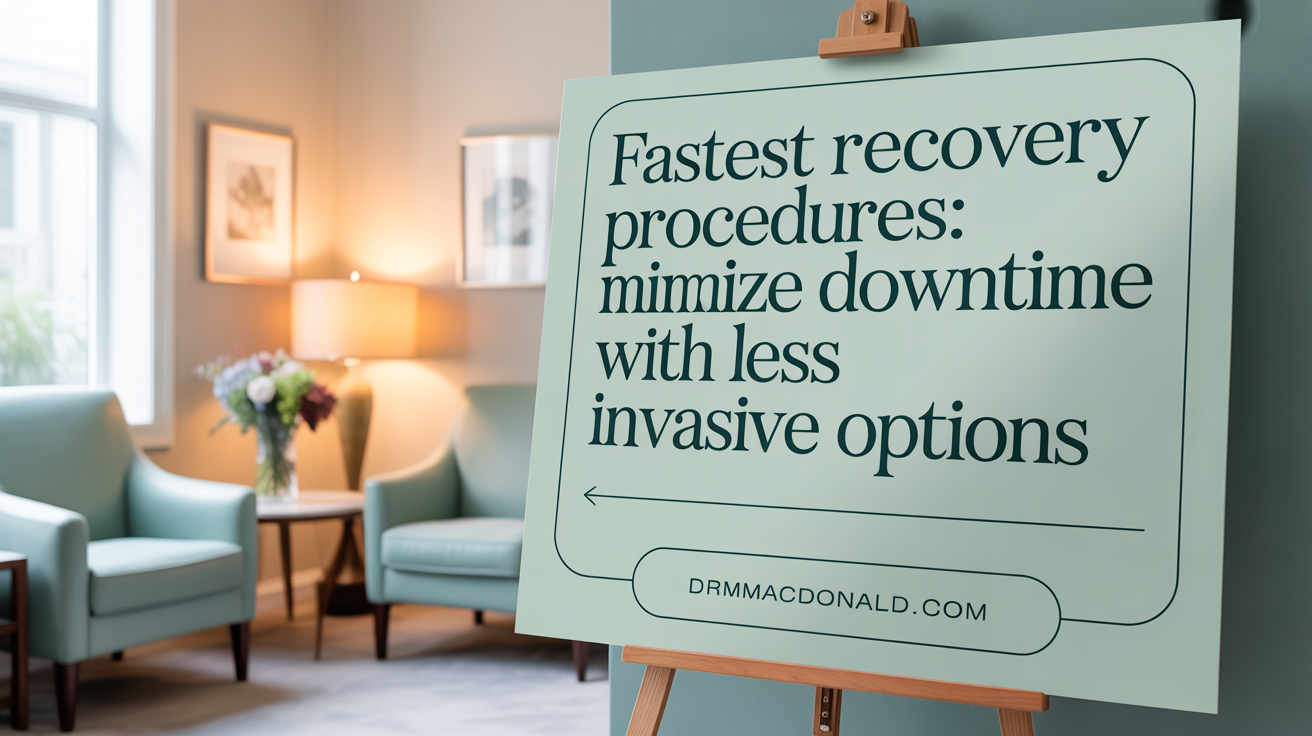
Which plastic surgery procedures have the shortest recovery times?
Procedures that involve minimal invasiveness often allow patients to recover quickly and return to daily routines in a matter of days.
Non-invasive treatments like Botox and dermal fillers are among the fastest in terms of recovery. These treatments usually have no downtime, enabling patients to resume work and social activities immediately after the procedure.
For surgical procedures, eyelid surgery (blepharoplasty) typically permits patients to go back to work within about one week. This is because the procedure involves relatively small incisions and mild swelling compared to more extensive surgeries.
Liposuction performed under local anesthesia targets specific areas for fat removal. When performed on a small scale, patients can often start light activities or desk work within three to four days and return to normal routines within a week.
In-office facelift and arm lift procedures also tend to have quicker recovery periods. Patients usually feel comfortable resuming mild activities or work within three to four days due to smaller incisions and less tissue disruption.
Overall, less invasive options like Botox, fillers, eyelid surgeries, and localized liposuction are favored for those seeking rapid recovery and minimal interruption to daily life.
| Procedure Type | Typical Recovery Time | Additional Notes |
|---|---|---|
| Botox/Dermal Fillers | Immediate | No downtime, resume normal activities right away |
| Eyelid Surgery (Blepharoplasty) | 1 week | Mild swelling, return to work quickly |
| Localized Liposuction | 3-4 days to a week | Less invasive, quick recovery |
| Office-based Facelifts | 3-4 days | Smaller incisions, minimal discomfort |
Procedures with minimal downtime provide excellent options for those wishing to improve appearance without significant disruption to their routines.
Factors Influencing Healing Times and Recovery Outcomes

What factors influence healing times and recovery outcomes after plastic surgery?
Recovery after plastic surgery varies greatly depending on a mix of biological, lifestyle, and surgical factors.
Biological factors include the type and extent of the procedure, as well as individual patient characteristics such as age, immune function, and overall health. For example, invasive surgeries like tummy tucks and facelifts usually require longer healing times compared to less invasive treatments such as Botox or fillers.
Pre-existing health conditions, especially those affecting blood flow like diabetes and cardiovascular issues, can slow down healing. Obesity is another significant factor, as it impairs tissue oxygenation and increases the risk of wound complications. Nutritional status plays a role too; deficiencies in vitamins and minerals like vitamin D, zinc, and iron can hinder the healing process.
Lifestyle choices are crucial. Smoking and alcohol consumption negatively affect circulation and immune responses, delaying recovery and raising infection risk.
Postoperative care, including adequate rest, proper wound management, staying hydrated, and avoiding strenuous activity, greatly influences healing speed. Wearing compression garments and using supplements such as Arnica and Bromelain can reduce swelling and bruising, supporting quicker recovery.
Surgical technique also impacts healing. Less invasive methods tend to heal faster, while surgical procedures with longer operative times and larger incisions necessitate extended recovery periods.
In summary, optimal healing relies on a combination of surgical strategy, individual health, lifestyle habits, and diligent postoperative care. Understanding these factors helps tailor recovery plans and set realistic expectations for healing timelines and outcomes.
Healing Timelines for Various Plastic Surgery Procedures
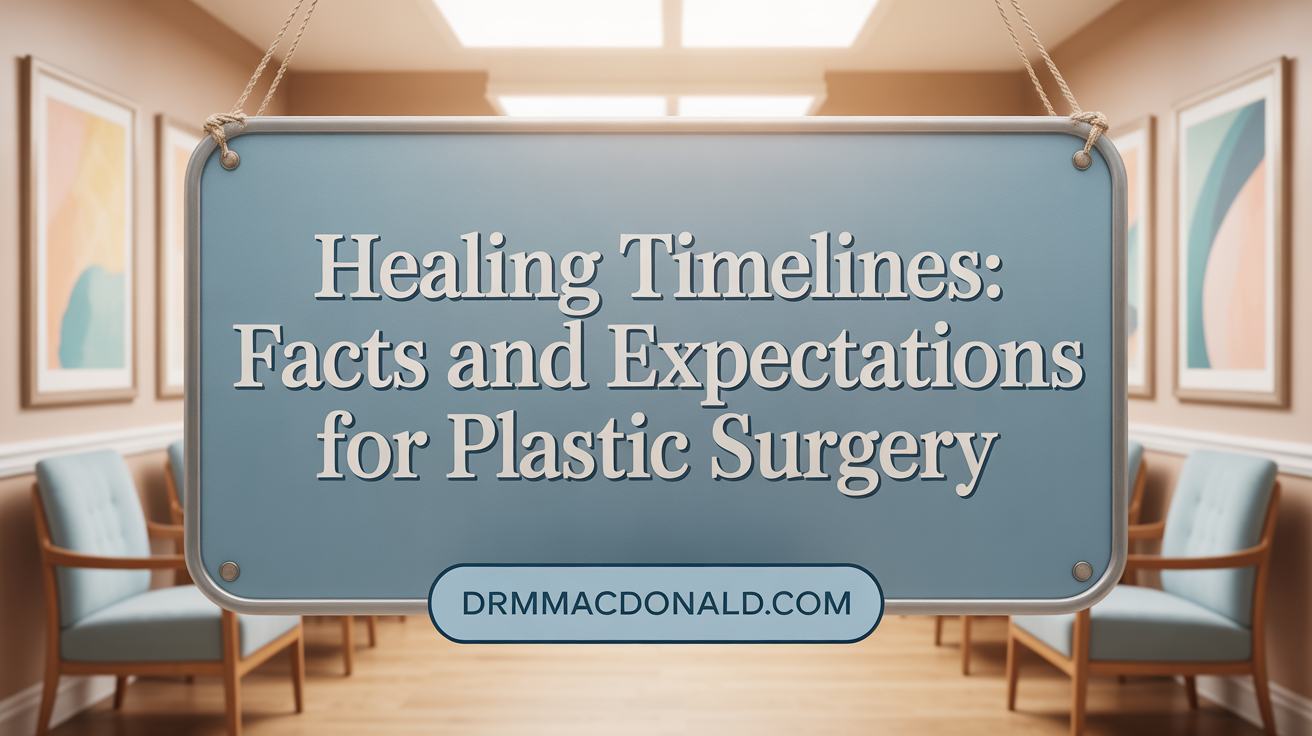 Understanding the typical recovery timeframes for different plastic surgeries helps patients plan effectively and set realistic expectations.
Understanding the typical recovery timeframes for different plastic surgeries helps patients plan effectively and set realistic expectations.
For less invasive treatments like BOTOX® injections or dermal fillers, recovery is rapid, often allowing patients to return to work within a few days, with minimal downtime. In contrast, procedures involving incisions and tissue manipulation, such as facelift or neck lift surgeries, generally require about 10 to 14 days off work. Full recovery, including the resolution of swelling and scars fading, can take several months, often up to three to six months.
Liposuction recovery varies depending on the area treated. Usually, patients can resume light activities within two weeks, with most swelling subsiding over 4-6 weeks. Yet, final results—characterized by reduced swelling and improved contour—may not be evident until three to six months.
Abdominoplasty or tummy tuck procedures typically need at least two weeks of recovery before returning to light activities. Complete healing, including scar maturation and residual swelling reduction, may extend to six to eight weeks, with significant improvements continuing for up to a year.
Facelifts typically involve a recovery period of about two weeks for returning to work, but patients should expect swelling and bruising to fade gradually, with final results becoming visible after three months. Similarly, eyelid surgery (blepharoplasty) patients often return to daily routines within 1-2 weeks, but residual swelling can persist for months.
Invasive surgeries like breast augmentation usually allow patients to go back to work within a week, although full healing—including volume settling and scar maturation—may take six weeks to a few months.
Overall, tissue healing, swelling reduction, and scar maturation are processes that gradually extend over weeks to more than a year, emphasizing the importance of following post-operative care instructions.
| Procedure | Return to Work | Full Recovery Expected | Approximate Duration of Swelling | Notes |
|---|---|---|---|---|
| BOTOX®, Fillers | 1-3 days | N/A | N/A | Minimal downtime |
| Facelift | 10-14 days | 3-6 months | Several months | Swelling fades over time |
| Tummy Tuck | 2-4 weeks | 6-8 weeks | 1-3 months | Scars take longer to mature |
| Liposuction | 2-4 weeks | 3-6 months | 4-6 weeks | Swelling persists for months |
| Rhinoplasty | 1-2 weeks | Up to a year | Up to a year | Swelling can last long |
| Breast Augmentation | 1 week | 6 weeks to several months | Several weeks | Final results evolve gradually |
Adherence to post-procedure care and healthy lifestyle choices play vital roles in ensuring smooth healing and optimal results.
Common Risks, Challenges, and Complications Associated With Plastic Surgery Recovery Periods
What are common risks, challenges, and complications associated with plastic surgery recovery?
While many patients recover smoothly, there are several risks and challenges they should be aware of following plastic surgery. Infection is one of the most common complications, varying from mild skin infections to severe cases like necrotizing fasciitis, which may require antibiotics or even surgical intervention.
Scarring is another concern. Although surgeons aim for minimal and hidden scars, abnormal or excessive scarring can occur, affecting appearance and comfort. Additionally, fluid buildup such as hematomas (blood collections) or seromas (fluid collection) can happen, sometimes needing drainage.
Nerve damage is a serious risk, potentially leading to numbness, tingling, or loss of sensation, especially in procedures involving the face, breasts, or limbs. Sometimes, nerve injury may be temporary, but in rare cases, it can be permanent.
Delayed wound healing is also a challenge, particularly in patients with pre-existing health issues like diabetes or in those who smoke, as these factors impair blood flow and tissue repair. Unique procedure-specific risks may include implant rupture, capsular contracture, contour irregularities, or tissue necrosis, which can compromise results.
More serious but less common complications include fat embolism syndrome, blood clots, reactions to anesthesia, and injury to internal organs during surgery.
To minimize these risks, thorough preoperative assessment, proper surgical technique, strict adherence to postoperative care, and choosing experienced surgeons are crucial. Ensuring patients follow all guidelines helps promote safe healing and optimal outcomes.
Informing Patient Expectations Regarding Recovery Periods and Healing Stages
How can patients better inform their expectations regarding recovery periods and healing stages after plastic surgery?
Managing expectations about recovery is a vital part of the surgical process. Patients should start by having detailed discussions with their surgeon about what to expect at each stage of healing. This includes understanding the typical timeline for swelling, bruising, and pain, as well as when they can anticipate returning to normal activities.
Recovery times can vary significantly depending on the specific procedure, as well as individual factors like age, overall health, and lifestyle. For instance, less invasive treatments like Botox or fillers may require only a few days of recovery, while more involved procedures such as tummy tucks or facelifts might necessitate several weeks.
To aid recovery and set realistic expectations, patients are encouraged to follow all post-operative instructions carefully. This includes taking prescribed medications, wearing compression garments, and maintaining proper nutrition. Attending follow-up appointments allows the surgeon to monitor healing progress and address any concerns promptly.
Creating a comfortable environment at home for rest and care can make a big difference. Recognizing the signs of potential complications—such as excessive swelling, pain, or signs of infection—is crucial for safety.
Effective communication with the surgical team throughout recovery helps clarify doubts and adapt care plans as needed. Patience is essential; healing is a gradual process that involves multiple phases—from initial inflammation to tissue regeneration and scar maturation.
Ultimately, understanding that final results may take several months to a year helps prepare patients emotionally and physically for the journey ahead. Being well-informed and proactive in recovery efforts contributes to a smoother healing experience and more satisfying outcomes.
Evidence-Based Statistical Data on Plastic Surgery Recovery and Healing Processes
What evidence-based statistical data exists about plastic surgery recovery and healing processes?
There is a wealth of statistical information available that illustrates the variability in recovery times for various plastic surgery procedures. For most patient cases, routine activities such as returning to work or light exercise typically occur within 1 to 4 weeks after surgery.
For example, patients undergoing facelift surgery often return to their daily routines within about two weeks, though full healing and final results may take several months. In contrast, rhinoplasty patients generally see the initial reduction in swelling within two weeks, but subtle swelling can persist for up to a year.
National data from the American Society of Plastic Surgeons (ASPS) indicates that procedures like abdominoplasty (tummy tuck) require about six to eight weeks for full recovery, whereas less invasive treatments like Botox or facial fillers often allow patients to resume normal activities within the same day or after a few days.
Over time, there has been a notable increase in both cosmetic and reconstructive procedures. For instance, in 2019 alone, over 1.8 million cosmetic surgeries were performed in the U.S. with breast augmentation and liposuction leading the numbers. These trends influence recovery protocols, as an increase in procedures like body contouring (which has longer recovery periods) results in more structured post-operative care.
While detailed, procedure-specific statistical data continues to evolve, surveys conducted among board-certified plastic surgeons provide valuable insight into average recovery timelines. These statistics help set realistic expectations for patients, although individual recovery can vary depending on health, age, and adherence to post-op care.
Overall, ongoing research and data collection are crucial to refining recovery estimates, ensuring that patients receive accurate, evidence-based guidance on their healing expectations.
Trends and Patterns Observed in Plastic Surgery Healing and Recovery Data

What trends and patterns are observed in plastic surgery healing and recovery data?
Recent data in the field of plastic surgery highlight a noticeable shift towards minimally invasive procedures. These surgeries generally involve smaller incisions, less tissue trauma, and shorter recovery periods. For example, procedures like Botox, dermal fillers, and sclerotherapy are increasingly popular due to their quick results and minimal downtime.
Technological advancements, such as collagen-stimulating treatments like Ultherapy and other non-invasive skin tightening methods, have contributed to achieving natural-looking results with faster healing. These options appeal to patients seeking subtle improvements without extended recovery.
Patient preferences are also influencing trends. An increasing number of individuals favor non-invasive or less invasive procedures to reduce risks and avoid lengthy recovery times. Social media influence and trends in self-care emphasize quick, visible improvements, reinforcing this preference.
In addition, personalized postoperative care has gained importance. Tailoring recovery plans based on factors like age, overall health, and individual healing responses enhances outcomes. This approach helps minimize complications like swelling, bruising, and scarring.
Overall, the pattern indicates a move towards safer, more efficient, and more natural-looking recovery experiences. The combination of advanced technology, patient-centered care, and social influences shapes current and future trends in plastic surgery healing.
Final Thoughts on Plastic Surgery Healing Times
Recovery after plastic surgery is a complex, multifaceted process influenced by the type of procedure, patient-specific factors, and diligent postoperative care. Understanding the biological phases of healing, typical timelines, and potential challenges can empower patients to have realistic expectations and adhere to recommendations that support optimal outcomes. Advances in surgical techniques and an increasing emphasis on minimally invasive procedures continue to improve recovery experiences and reduce downtime. Ultimately, successful healing depends on personalized care, patience, and a well-informed approach to the recovery journey.
References
- What's normal? Your cosmetic surgery recovery explained
- The Truth About Recovery Times in Plastic Surgery - Dr. Alspaugh
- What Is the Average Liposuction Recovery Time?
- Bounce back, babe? Why your plastic surgery recovery takes time
- Tendon: Principles of Healing and Repair - PMC - PubMed Central
- Plastic Surgery Statistics & Facts - Robin Recovery
- Plastic Surgery Statistics & Facts - Conifer Park
